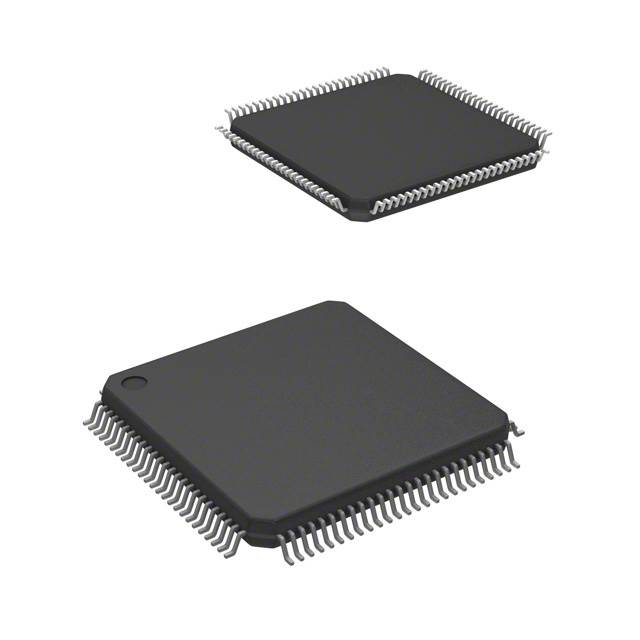Viz Specifikace pro podrobnosti o produktu.

ATSAM4CMP8CA-AU
Product Overview
Category: Microcontroller
Use: Embedded systems, Internet of Things (IoT) devices
Characteristics: High-performance, low-power consumption, advanced peripherals
Package: 64-pin LQFP
Essence: ARM Cortex-M4 processor-based microcontroller
Packaging/Quantity: Tray packaging, 250 units per tray
Specifications
- Processor: ARM Cortex-M4
- Clock Speed: Up to 120 MHz
- Flash Memory: 512 KB
- SRAM: 160 KB
- Operating Voltage: 1.62V to 3.6V
- Digital I/O Pins: 54
- Analog Input Channels: 16
- Communication Interfaces: UART, SPI, I2C, USB, CAN
- Operating Temperature Range: -40°C to +85°C
Pin Configuration
The ATSAM4CMP8CA-AU microcontroller has a total of 64 pins. The pin configuration is as follows:

Functional Features
- High-performance ARM Cortex-M4 processor for efficient execution of complex tasks
- Low-power consumption for extended battery life in portable devices
- Advanced peripherals such as UART, SPI, I2C, USB, and CAN for seamless communication
- Ample flash memory and SRAM for storing and processing data
- Wide operating voltage range for flexibility in various applications
- Robust operating temperature range for reliable performance in harsh environments
Advantages and Disadvantages
Advantages: - High-performance processor enables efficient execution of complex tasks - Low-power consumption extends battery life in portable devices - Advanced peripherals facilitate seamless communication - Ample memory for storing and processing data - Wide operating voltage range allows flexibility in various applications - Robust operating temperature range ensures reliable performance in harsh environments
Disadvantages: - Limited flash memory and SRAM compared to some other microcontrollers in the same category - Higher cost compared to entry-level microcontrollers
Working Principles
The ATSAM4CMP8CA-AU microcontroller is based on the ARM Cortex-M4 processor architecture. It operates by executing instructions stored in its flash memory, which are fetched and processed by the processor. The microcontroller interacts with external devices through its various communication interfaces, enabling data exchange and control. Its advanced peripherals and low-power consumption make it suitable for a wide range of embedded systems and IoT applications.
Detailed Application Field Plans
The ATSAM4CMP8CA-AU microcontroller finds applications in various fields, including but not limited to: - Home automation systems - Industrial automation - Smart energy management - Automotive electronics - Medical devices - Consumer electronics
Alternative Models
- ATSAM4CMP16CA-AU: Similar to ATSAM4CMP8CA-AU but with double the flash memory and SRAM capacity.
- ATSAM4CMP32CA-AU: Similar to ATSAM4CMP8CA-AU but with quadruple the flash memory and SRAM capacity.
- ATSAM4CMP64CA-AU: Similar to ATSAM4CMP8CA-AU but with eight times the flash memory and SRAM capacity.
These alternative models provide increased memory capacity for applications that require more storage and processing capabilities.
In conclusion, the ATSAM4CMP8CA-AU microcontroller is a high-performance ARM Cortex-M4-based microcontroller with advanced peripherals and low-power consumption. It is suitable for a wide range of embedded systems and IoT applications, offering flexibility, reliability, and efficient execution of complex tasks.
Seznam 10 běžných otázek a odpovědí souvisejících s aplikací ATSAM4CMP8CA-AU v technických řešeních
Sure! Here are 10 common questions and answers related to the application of ATSAM4CMP8CA-AU in technical solutions:
Q: What is the ATSAM4CMP8CA-AU microcontroller used for? A: The ATSAM4CMP8CA-AU is a microcontroller designed for various embedded applications, including industrial automation, consumer electronics, and Internet of Things (IoT) devices.
Q: What is the maximum clock frequency supported by the ATSAM4CMP8CA-AU? A: The ATSAM4CMP8CA-AU can operate at a maximum clock frequency of 120 MHz.
Q: How much flash memory does the ATSAM4CMP8CA-AU have? A: The ATSAM4CMP8CA-AU has 512 KB of flash memory for storing program code and data.
Q: Does the ATSAM4CMP8CA-AU support analog-to-digital conversion (ADC)? A: Yes, the ATSAM4CMP8CA-AU features a built-in 12-bit ADC with multiple channels for analog signal acquisition.
Q: Can I connect external peripherals to the ATSAM4CMP8CA-AU? A: Absolutely! The ATSAM4CMP8CA-AU offers a wide range of peripheral interfaces, including UART, SPI, I2C, USB, and GPIOs, allowing you to connect external devices easily.
Q: Is the ATSAM4CMP8CA-AU suitable for low-power applications? A: Yes, the ATSAM4CMP8CA-AU incorporates power-saving features such as sleep modes, which make it ideal for battery-powered or energy-efficient designs.
Q: Does the ATSAM4CMP8CA-AU support real-time operating systems (RTOS)? A: Yes, the ATSAM4CMP8CA-AU is compatible with various RTOS options, enabling you to develop multitasking applications efficiently.
Q: Can I program the ATSAM4CMP8CA-AU using C/C++ languages? A: Yes, the ATSAM4CMP8CA-AU can be programmed using popular programming languages like C and C++, along with development tools such as Atmel Studio or third-party IDEs.
Q: What is the operating voltage range of the ATSAM4CMP8CA-AU? A: The ATSAM4CMP8CA-AU operates within a voltage range of 1.62V to 3.6V.
Q: Is the ATSAM4CMP8CA-AU suitable for secure applications? A: Yes, the ATSAM4CMP8CA-AU provides hardware security features like a True Random Number Generator (TRNG) and cryptographic acceleration, making it suitable for secure applications.
Please note that these answers are general and may vary depending on specific implementation requirements.

